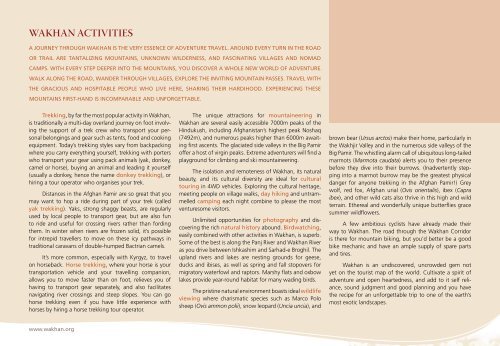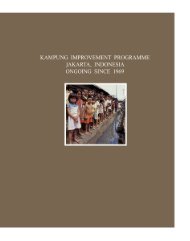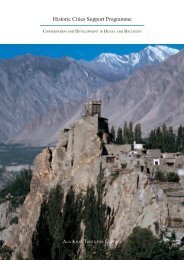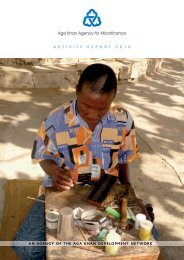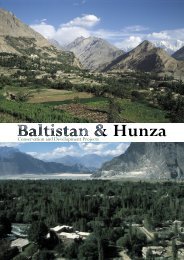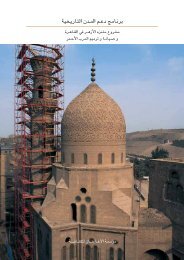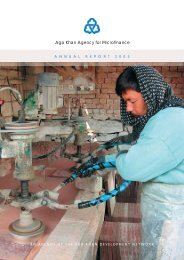WAKHAN & the AFGHAN PAMIR - Aga Khan Development Network
WAKHAN & the AFGHAN PAMIR - Aga Khan Development Network
WAKHAN & the AFGHAN PAMIR - Aga Khan Development Network
Create successful ePaper yourself
Turn your PDF publications into a flip-book with our unique Google optimized e-Paper software.
<strong>WAKHAN</strong> ACTIVITIESA JOURNEY THROUGH <strong>WAKHAN</strong> IS THE VERY ESSENCE OF ADVENTURE TRAVEL. AROUND EVERY TURN IN THE ROADOR TRAIL ARE TANTALIZING MOUNTAINS, UNKNOWN WILDERNESS, AND FASCINATING VILLAGES AND NOMADCAMPS. WITH EVERY STEP DEEPER INTO THE MOUNTAINS, YOU DISCOVER A WHOLE NEW WORLD OF ADVENTURE.WALK ALONG THE ROAD, WANDER THROUGH VILLAGES, EXPLORE THE INVITING MOUNTAIN PASSES. TRAVEL WITHTHE GRACIOUS AND HOSPITABLE PEOPLE WHO LIVE HERE, SHARING THEIR HARDIHOOD. EXPERIENCING THESEMOUNTAINS FIRST-HAND IS INCOMPARABLE AND UNFORGETTABLE.Trekking, by far <strong>the</strong> most popular activity in Wakhan,is traditionally a multi-day overland journey on foot involving<strong>the</strong> support of a trek crew who transport your personalbelongings and gear such as tents, food and cookingequipment. Today’s trekking styles vary from backpackingwhere you carry everything yourself, trekking with porterswho transport your gear using pack animals (yak, donkey,camel or horse), buying an animal and leading it yourself(usually a donkey, hence <strong>the</strong> name donkey trekking), orhiring a tour operator who organises your trek.Distances in <strong>the</strong> Afghan Pamir are so great that youmay want to hop a ride during part of your trek (calledyak trekking). Yaks, strong shaggy beasts, are regularlyused by local people to transport gear, but are also funto ride and useful for crossing rivers ra<strong>the</strong>r than fording<strong>the</strong>m. In winter when rivers are frozen solid, it’s possiblefor intrepid travellers to move on <strong>the</strong>se icy pathways intraditional caravans of double-humped Bactrian camels.It’s more common, especially with Kyrgyz, to travelon horseback. Horse trekking, where your horse is yourtransportation vehicle and your travelling companion,allows you to move faster than on foot, relieves you ofhaving to transport gear separately, and also facilitatesnavigating river crossings and steep slopes. You can gohorse trekking even if you have little experience withhorses by hiring a horse trekking tour operator.The unique attractions for mountaineering inWakhan are several easily accessible 7000m peaks of <strong>the</strong>Hindukush, including Afghanistan’s highest peak Noshaq(7492m), and numerous peaks higher than 6000m awaitingfirst ascents. The glaciated side valleys in <strong>the</strong> Big Pamiroffer a host of virgin peaks. Extreme adventurers will find aplayground for climbing and ski mountaineering.The isolation and remoteness of Wakhan, its naturalbeauty, and its cultural diversity are ideal for culturaltouring in 4WD vehicles. Exploring <strong>the</strong> cultural heritage,meeting people on village walks, day hiking and untrammelledcamping each night combine to please <strong>the</strong> mostventuresome visitors.Unlimited opportunities for photography and discovering<strong>the</strong> rich natural history abound. Birdwatching,easily combined with o<strong>the</strong>r activities in Wakhan, is superb.Some of <strong>the</strong> best is along <strong>the</strong> Panj River and Wakhan Riveras you drive between Ishkashim and Sarhad-e Broghil. Theupland rivers and lakes are nesting grounds for geese,ducks and ibises, as well as spring and fall stopovers formigratory waterfowl and raptors. Marshy flats and oxbowlakes provide year-round habitat for many wading birds.The pristine natural environment boasts ideal wildlifeviewing where charismatic species such as Marco Polosheep (Ovis ammon polii), snow leopard (Uncia uncia), andbrown bear (Ursus arctos) make <strong>the</strong>ir home, particularly in<strong>the</strong> Wakhjir Valley and in <strong>the</strong> numerous side valleys of <strong>the</strong>Big Pamir. The whistling alarm call of ubiquitous long-tailedmarmots (Marmota caudata) alerts you to <strong>the</strong>ir presencebefore <strong>the</strong>y dive into <strong>the</strong>ir burrows. (Inadvertently steppinginto a marmot burrow may be <strong>the</strong> greatest physicaldanger for anyone trekking in <strong>the</strong> Afghan Pamir!) Greywolf, red fox, Afghan urial (Ovis orientalis), ibex (Capraibex), and o<strong>the</strong>r wild cats also thrive in this high and wildterrain. E<strong>the</strong>real and wonderfully unique butterflies gracesummer wildflowers.A few ambitious cyclists have already made <strong>the</strong>irway to Wakhan. The road through <strong>the</strong> Wakhan Corridoris <strong>the</strong>re for mountain biking, but you’d better be a goodbike mechanic and have an ample supply of spare partsand tires.Wakhan is an undiscovered, uncrowded gem notyet on <strong>the</strong> tourist map of <strong>the</strong> world. Cultivate a spirit ofadventure and open heartedness, and add to it self reliance,sound judgment and good planning and you have<strong>the</strong> recipe for an unforgettable trip to one of <strong>the</strong> earth’smost exotic landscapes.THE WEATHERWakhan is at its best during <strong>the</strong> short summer, whichlasts from late June to mid-September. It is followed by along winter from late September to early June with coldtemperatures and severe, snowy conditions characteristicof this subarctic mountain climate. Wakhan receivesfewer than 10cm of annual rainfall, much of it coming in<strong>the</strong> form of snowfall. Infamously fierce winds known asbad-e Wakhan blow throughout <strong>the</strong> year, fueling summerdust storms and winter blizzards. Unpredictable andchangeable wea<strong>the</strong>r is a given in <strong>the</strong> mountains, and it cansnow any month of <strong>the</strong> year in <strong>the</strong> Afghan Pamir.WHEN TO GOThe tourist season in Wakhan is relatively short, starting inMay or June and lasting until September or early October.From April to early June, melting snow swells rivers andhigh water blocks road access to many areas, making somerivers crossings impassable by foot, animal or vehicle.Many areas only become accessible as of early July. Thelater in summer you travel, <strong>the</strong> easier it is to cross streamsand rivers, and <strong>the</strong> greater <strong>the</strong> likelihood of being able todrive as far as Sarhad-e Broghil. August to mid-Septemberis <strong>the</strong> optimal travel time. By early September, however,snow can close trails and roads for <strong>the</strong> season.CULTURAL CONSIDERATIONSTHE RESPECTFUL TOURIST:behaves conservatively as a show of respect for <strong>the</strong> local cultureis humble and grateful when accepting offers of local food whilenot taking advantage of generous hospitality, and pays for foodand accommodationwears loose, long-sleeved, unrevealing shirts, and full-lengthpants that cover <strong>the</strong> ankleswearing a hat or scarf is optional for women travelling throughWakhi and Kyrgyz areas, but is advisable elsewhere in Badakhshandoesn’t drink alcohol in public viewrefrains from all public displays of affectioncontributes to <strong>the</strong> local economy by patronizing local businesses,hiring porters and buying local products, which encourages localpeople to conserve <strong>the</strong>ir natural resource baseasks permission before photographing people or sacred placesmakes donations through established organizations orrespected community leaders, and doesn’t give handouts tobeggars or childrenENVIRONMENTAL CONSIDERATIONSTHE RESPECTFUL TOURIST:lessens <strong>the</strong> negative impact on <strong>the</strong> environmenttravels in a small party to minimise overall impact, but avoidstravelling alonecooks on a kerosene stove avoiding wood or dung fires since<strong>the</strong>se fuels are a scarce resource that belong to <strong>the</strong> local peoplebrings adequate warm clothing to avoid relying on campfiresfor warmthba<strong>the</strong>s, washes dishes and clo<strong>the</strong>s with a basin and discardssoapy water at least 50m from water sourcesrelieves one’s self at least 50m from open water sources orcampsites since toilets don’t existburns rubbish that can be burnt and packs out o<strong>the</strong>r rubbishleaves campsites <strong>the</strong> same way <strong>the</strong>y were on arrival; doesn’tclear vegetation, cut trees, limbs or branches, and doesn’t moverocks from walls or canalsdoesn’t write names or mark graffiti on rocksdoesn’t hunt or trade in endangered speciesrefrains from harassing or feeding wildlife or eating wild gamepatronises tour operators who commit to environmentallyresponsible tourismTHE RESPECTFUL TOURIST:is law abiding and obtains necessary permission(s) for <strong>the</strong> routerespects <strong>the</strong> sovereignty of international borders and obtains allrequired permission for cross-border routestakes responsibility for one’s actions and avoids foolhardy decisionsRECOMMENDED ITINERARIESfrom IshkashimWITH ONE WEEKDrive to Sarhad-e Broghil enjoying beautiful scenery, village walks,diverse cultural exchanges, and visits to intriguing roadside tombs,shrines and petroglyphs.A shorter road trip as far as Qila-e Panja allows for a side tripto <strong>the</strong> confluence of <strong>the</strong> Pamir and Wakhan Rivers and a visitto Avgarch village.The spectacular route to Noshaq Base Camp offers world-classtrekking just an hour’s drive from Ishkashim.WITH TWO WEEKSTry one longer route to picturesque Zorkol in <strong>the</strong> Big Pamir,or to <strong>the</strong> nearest Kyrgyz camps in <strong>the</strong> Little Pamir.Combine two routes by traversing <strong>the</strong> Big Pamir starting fromGoz Khun to Zorkol, and <strong>the</strong>n to Sarhad-e Broghil in Upper Wakhan.Attempt a cross-border route from Sarhad-e Broghil in UpperWakhan to Pakistan’s Nor<strong>the</strong>rn Areas.WITH THREE WEEKSVisit Chaqmaqtin Lake in <strong>the</strong> Little Pamir and outlyingKyrgyz settlements.Enjoy wildlife viewing in <strong>the</strong> Little Pamir’s Wakhjir Valley.Combine routes by visiting <strong>the</strong> Big Pamir and more remoteareas of <strong>the</strong> Little Pamir.www.wakhan.org


